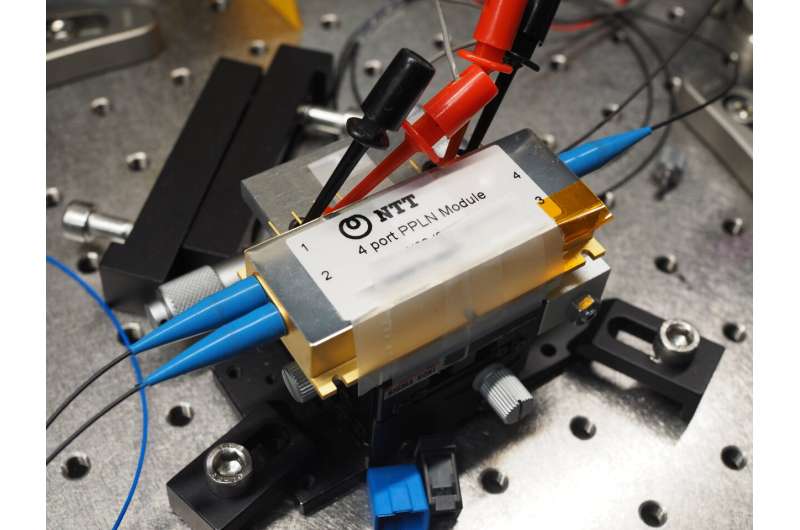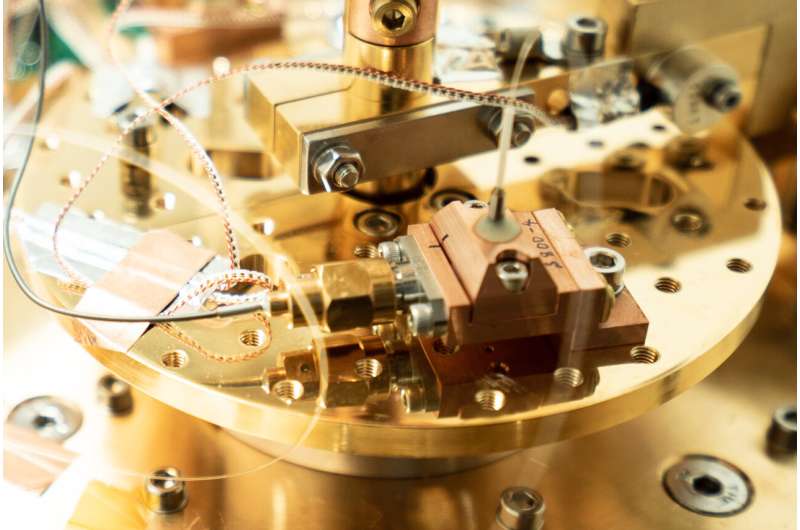Researchers generate high-quality quantum light with modular waveguide device

For the first time, researchers have successfully generated strongly nonclassical light using a modular waveguide-based light source. The achievement represents a crucial step toward creating faster and more practical optical quantum computers.
"Our goal is to dramatically improve information processing by developing faster quantum computers that can perform any type of computation without errors," said research team member Kan Takase from the University of Tokyo. "Although there are several ways to create a quantum computer, light-based approaches are promising because the information processor can operate at room temperature and the computing scale can be easily expanded."
In the Optica Publishing Group journal Optics Express, a multi-institutional team of researchers from Japan describe the waveguide optical parametric amplifier (OPA) module they created for quantum experiments. Combining this device with a specially designed photon detector allowed them to generate a state of light known as Schrödinger cat, which is a superposition of coherent states.
"Our method for generating quantum light can be used to increase the computing power of quantum computers and to make the information processer more compact," said Takase. "Our approach outperforms conventional methods, and the modular waveguide OPA is easy to operate and integrate into quantum computers."
Generating strongly nonclassical light
Continuous wave squeezed light is used to generate the various quantum states necessary to perform quantum computing. For the best computing performance, the squeezed light source must exhibit very low levels of light loss and be broadband, meaning it includes a wide range of frequencies.
"We want to increase the clock frequency of optical quantum computers, which can, in principle, achieve terahertz frequencies," said Takase. "Higher clock frequencies enable faster execution of computational tasks and allow the delay lines in the optical circuits to be shortened. This makes optical quantum computers more compact while also making it easier to develop and stabilize the overall system."

OPAs use nonlinear optical crystals to generate squeezed light, but conventional OPAs don't generate the quantum light with the properties necessary for faster quantum computing. To overcome this challenge, researchers from the University of Tokyo and NTT Corporation developed an OPA based on a waveguide-type device that achieves high efficiency by confining light to a narrow crystal.
By carefully designing the waveguide and manufacturing it with precision processing, they were able to create an OPA device with much smaller propagation loss than conventional devices. It can also be modularized for use in various experiments with quantum technologies.
Designing the right detector
The OPA device was designed to create squeezed light at telecommunications wavelengths, a wavelength region that tends to exhibit low losses. To complete the system, researchers needed a high-performance photon detector that worked at telecom wavelengths. However, standard photon detectors based on semiconductors don't meet the performance requirements for this application.
Thus, researchers from University of Tokyo and National Institute of Information and Communications Technology (NICT) developed a detector designed specifically for quantum optics. The new superconducting nanostrip photon detector (SNSPD) uses superconductivity technology to detect photons.
"We combined our new waveguide OPA with this photon detector to generate a highly non-classical—or quantum—state of light called Schrödinger cat," said Takase. "Generating this state, which is difficult with conventional, low-efficiency waveguide OPAs, confirms the high performance of our waveguide OPA and opens the possibility of using this device for a wide range of quantum experiments."
The researchers are now looking at how to combine high-speed measurement techniques with the new waveguide OPA to get closer to their goal of ultrafast optical quantum computing.
More information: Kan Takase et al, Generation of Schrödinger cat states with Wigner negativity using a continuous-wave low-loss waveguide optical parametric amplifier, Optics Express (2022). DOI: 10.1364/OE.454123
Journal information: Optics Express
Provided by Optica




















